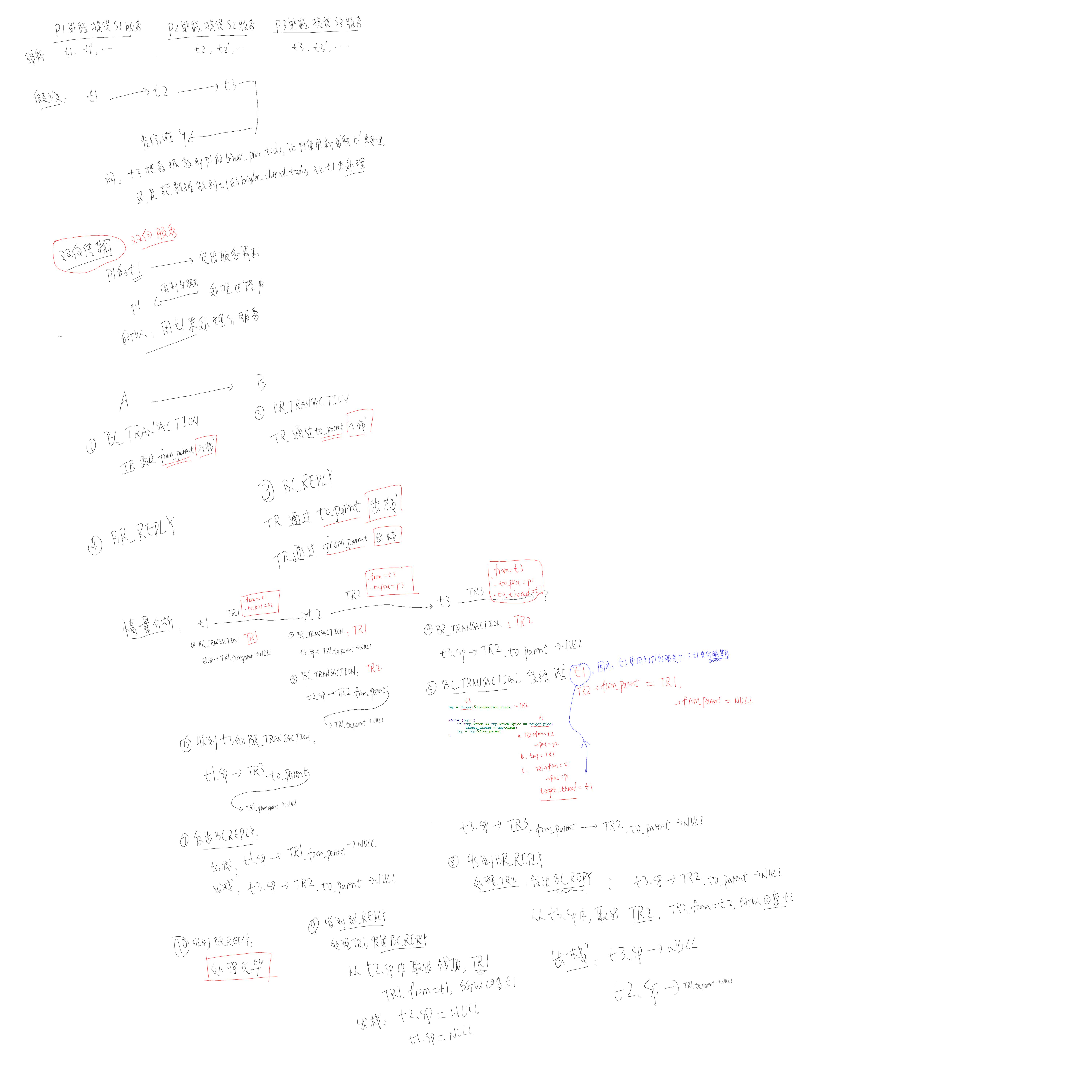9.5 Binder系统_驱动情景分析_transaction_stack机制
Posted 拉风摊主
tags:
篇首语:本文由小常识网(cha138.com)小编为大家整理,主要介绍了9.5 Binder系统_驱动情景分析_transaction_stack机制相关的知识,希望对你有一定的参考价值。
参考文章:
http://www.cnblogs.com/samchen2009/p/3316001.html
test_server服务进程可能有多个线程,而在发送数据的时候handle只表示了那个进程
(1)发给谁?handle只表示了那个进程,数据是发给进程还是某个线程
一般数据放在binder_proc的todo链表,其会唤醒等待与binder_proc.wait上的空闲线程;
对于双向传输,则放在binder_thread.todo链表上,然后唤醒该线程(用transaction_stack来判断是否是双向传输)
(2)回复给谁?没有handle表示目的进程,必定在某个地方记录之前的发送者
某个地方就是transaction_stack
test_client步骤分析:
(1)发送BC_TRANSACTION类型数据
a、单进程也会有一个binder_thread,其在调用ioctl的时候被创建,其thread->transaction_stack开始为空,表示非双向传输。
b、入栈 test_client里面的binder_thread.transaction_stack结构,其指向的就是binder_transaction结构体,binder_transaction结构体的成员from_parent = transaction_stack,刚开始为null、from=test_client、to_proc=test_server、to_thread = thread(test_server的某个线程,单线程的时候就是test_server)
c、数据将放在test_server的binder_proc.todo链表中;唤醒test_server的binder_proc.wait上的线程
(4)接受BR_REPLY类型数据
唤醒后返回给用户空间,不涉及栈
test_server步骤分析:
(2)接受BR_TRANSACTION类型数据
在binder_thread_read函数中做如下事情:
a、从test_server的binder_proc.todo链表中取出数据处理
b、入栈 test_server里面的binder_thread.transaction_stack结构,其指向的就是binder_transaction结构体,binder_transaction结构体的成员to_parent = transaction_stack,刚开始为null、from=test_client、to_proc=test_server、to_thread = thread((test_server的某个线程,单线程的时候就是test_server))
(这里的binder_transaction和test_client中的binder_transaction是一个,通过from_parent放入发送者的栈,通过to_parent放入接受者的栈,transaction_stack的字面意思就是传输栈)
(3)发送BC_REPLY类型数据
a、发送给谁:从栈中取出binder_transaction,其中from=test_client、to_proc=test_server、to_thread = thread,可知要回复给前面的发送者test_client
b、出栈, test_server里面的binder_thread.transaction_stack结构等于in_reliy_to->to_parent,其为NULL,即transaction_stack等于NULL
c、数据copy_from_user进内核态传给test_client
d、出栈, test_client里面的binder_thread.transaction_stack结构等于transaction_stack->from_parent,其为NULL,即transaction_stack等于NULL
e、放入todo链表,唤醒
在双向传输过程中transaction_stack的作用
P1进程提供S1服务,其有线程t1、t11
P2进程提供S2服务,其有线程t2、t22
P3进程提供S3服务,其有线程t3、t33
假设:t1线程要使用S2服务,它会给t2线程发送数据,t2线程在处理过程中要用到S3服务,它会给t2线程发送数据,如果t3线程又要用到S1服务,这个时候t3是给t1还是新建个线程t11发送数据呢
如果新建一个线程,那么只要调用S1服务就新建一次,这样太浪费资源了,所以t3是给t1发送数据,这就是双向传输
即:P1的t1发送服务请求后休眠,在服务处理过程中又用到S1服务,会发送服务请求给P1的t1来处理S1服务
情景分析:
一、t1传送binder_transaction1结构体给t2:
(1)t1发送BC_TRANSACTION
t1.sp(栈).binder_transaction1.form_parent = NULL
binder_transaction1.from = t1;
binder_transaction1.to_proc = P2;
binder_transaction1.from_parent = NULL;
(4)收到t3的BR_TRANSACTION
t1.sp(栈).binder_transaction3.to_parent = binder_transaction1
(5)t1发出BC_REPLY
出栈:t1.sp(栈).binder_transaction1.form_parent = NULL
出栈:t3.sp(栈).binder_transaction2.to_parent =NULL
(8)t1收到t2的BR_REPLY 处理完毕
二、t2接受t1的binder_transaction1,然后发送binder_transaction2给t2
(2)t2接受BR_TRANSACTION
t2.sp(栈).binder_transaction1.to_parent = NULL
t2发送BC_TRANSACTION
t2.sp(栈).binder_transaction2.from_parent = binder_transaction1
binder_transaction2.from = t2;
binder_transaction2.to_proc = P3;
binder_transaction2.from_parent = binder_transaction1;
(7)t2收到t3的BR_REPLY
处理binder_transaction2,从t3.sp中取出binder_transaction1(栈顶),其成员from为t1,所以发出BC_REPLY给t1
出栈:t2.sp(栈) = NULL
出栈:t1.sp(栈) =NULL
(三)t3接受t2的binder_transaction2,然后发送binder_transaction3给t1(经过一窜代码分析出来是发给t1,不是发给P1,见图)
(3)t3接受BR_TRANSACTION
t3.sp(栈).binder_transaction2.to_parent = NULL
t3发送BC_TRANSACTION
t3.sp(栈).binder_transaction3.from_parent = binder_transaction2
binder_transaction3.from = t3;
binder_transaction3.to_proc = P1;
binder_transaction3.to_thread= t1;
(6)t3收到t1发送的BR_REPLY
处理binder_transaction1,从t2.sp中取出binder_transaction2(栈顶),其成员from为t2,所以发出BC_REPLY给t2
出栈:t3.sp(栈) = NULL
出栈:t2.sp(栈).binder_transaction1.to_parent =NULL

以上是关于9.5 Binder系统_驱动情景分析_transaction_stack机制的主要内容,如果未能解决你的问题,请参考以下文章